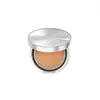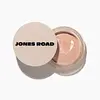What's inside
What's inside
 Key Ingredients
Key Ingredients

 Benefits
Benefits

 Concerns
Concerns

 Ingredients Side-by-side
Ingredients Side-by-side

Water
Skin ConditioningCI 77891
Cosmetic ColorantPropanediol
SolventPolyglyceryl-10 Pentaisostearate
EmollientCetyl Ethylhexanoate
EmollientIsoamyl Laurate
EmollientC15-19 Alkane
SolventPentylene Glycol
Skin ConditioningIsododecane
EmollientCaprylic/Capric Triglyceride
MaskingNiacinamide
SmoothingCI 77120
Cosmetic ColorantSynthetic Fluorphlogopite
Polyglyceryl-6 Polyricinoleate
EmulsifyingIron Oxides
Coco-Caprylate/Caprate
EmollientAlumina
AbrasiveSodium Chloride
MaskingTriheptanoin
Skin ConditioningDioctyldodecyl Dimer Dilinoleate
EmollientC9-12 Alkane
SolventDilinoleic Acid/Butanediol Copolymer
Aluminum Hydroxide
EmollientCI 77491
Cosmetic ColorantStearic Acid
CleansingPolyhydroxystearic Acid
EmulsifyingStearalkonium Hectorite
Gel FormingHectorite
AbsorbentCI 77499
Cosmetic ColorantSodium Lauroyl Glutamate
Ethylhexyl Palmitate
EmollientIsopropyl Myristate
EmollientIsostearic Acid
CleansingLecithin
EmollientAdenosine
Skin ConditioningTrisodium Ethylenediamine Disuccinate
Lysine
Skin ConditioningPolyglyceryl-3 Polyricinoleate
EmulsifyingPelargonium Graveolens Flower Oil
MaskingBoswellia Carterii Oil
MaskingMagnesium Chloride
Magnesium Myristate
Amyris Balsamifera Bark Oil
MaskingCastor Oil/Ipdi Copolymer
Vetiveria Zizanoides Root Oil
MaskingMelaleuca Alternifolia Leaf Oil
AntioxidantDaucus Carota Sativa Seed Oil
EmollientRose Flower Oil
MaskingCitrus Grandis Peel Oil
Masking1,2-Hexanediol
Skin ConditioningSodium Dna
Skin ConditioningSelaginella Tamariscina Extract
Skin ConditioningCentella Asiatica Extract
CleansingWater, CI 77891, Propanediol, Polyglyceryl-10 Pentaisostearate, Cetyl Ethylhexanoate, Isoamyl Laurate, C15-19 Alkane, Pentylene Glycol, Isododecane, Caprylic/Capric Triglyceride, Niacinamide, CI 77120, Synthetic Fluorphlogopite, Polyglyceryl-6 Polyricinoleate, Iron Oxides, Coco-Caprylate/Caprate, Alumina, Sodium Chloride, Triheptanoin, Dioctyldodecyl Dimer Dilinoleate, C9-12 Alkane, Dilinoleic Acid/Butanediol Copolymer, Aluminum Hydroxide, CI 77491, Stearic Acid, Polyhydroxystearic Acid, Stearalkonium Hectorite, Hectorite, CI 77499, Sodium Lauroyl Glutamate, Ethylhexyl Palmitate, Isopropyl Myristate, Isostearic Acid, Lecithin, Adenosine, Trisodium Ethylenediamine Disuccinate, Lysine, Polyglyceryl-3 Polyricinoleate, Pelargonium Graveolens Flower Oil, Boswellia Carterii Oil, Magnesium Chloride, Magnesium Myristate, Amyris Balsamifera Bark Oil, Castor Oil/Ipdi Copolymer, Vetiveria Zizanoides Root Oil, Melaleuca Alternifolia Leaf Oil, Daucus Carota Sativa Seed Oil, Rose Flower Oil, Citrus Grandis Peel Oil, 1,2-Hexanediol, Sodium Dna, Selaginella Tamariscina Extract, Centella Asiatica Extract
Water
Skin ConditioningCaprylic/Capric Triglyceride
MaskingC12-15 Alkyl Benzoate
AntimicrobialCaprylic/Capric/Succinic Triglyceride
EmollientPropanediol
SolventSimmondsia Chinensis Seed Oil
EmollientOlea Europaea Fruit Oil
MaskingCoco-Caprylate/Caprate
EmollientDiisostearyl Malate
EmollientC9-12 Alkane
SolventPolyhydroxystearic Acid
EmulsifyingHydrogenated Castor Oil
EmollientRicinus Communis Seed Oil
MaskingHelianthus Annuus Seed Wax
Skin ConditioningStearalkonium Hectorite
Gel FormingEuphorbia Cerifera Wax
Polyglyceryl-3 Diisostearate
EmulsifyingPolyglyceryl-3 Polyricinoleate
EmulsifyingPhenoxyethanol
PreservativeCopernicia Cerifera Wax
Silica Silylate
EmollientSodium Chloride
MaskingPelargonium Graveolens Oil
MaskingTocopheryl Acetate
AntioxidantPolyglyceryl-6 Polyricinoleate
EmulsifyingTriethoxycaprylylsilane
Zingiber Officinale Root Oil
MaskingLecithin
EmollientSilica
AbrasiveBiosaccharide Gum-1
HumectantSodium Hyaluronate
HumectantMica
Cosmetic ColorantCI 77891
Cosmetic ColorantIron Oxides
Citronellol
PerfumingGeraniol
PerfumingLinalool
PerfumingLimonene
PerfumingCitral
PerfumingWater, Caprylic/Capric Triglyceride, C12-15 Alkyl Benzoate, Caprylic/Capric/Succinic Triglyceride, Propanediol, Simmondsia Chinensis Seed Oil, Olea Europaea Fruit Oil, Coco-Caprylate/Caprate, Diisostearyl Malate, C9-12 Alkane, Polyhydroxystearic Acid, Hydrogenated Castor Oil, Ricinus Communis Seed Oil, Helianthus Annuus Seed Wax, Stearalkonium Hectorite, Euphorbia Cerifera Wax, Polyglyceryl-3 Diisostearate, Polyglyceryl-3 Polyricinoleate, Phenoxyethanol, Copernicia Cerifera Wax, Silica Silylate, Sodium Chloride, Pelargonium Graveolens Oil, Tocopheryl Acetate, Polyglyceryl-6 Polyricinoleate, Triethoxycaprylylsilane, Zingiber Officinale Root Oil, Lecithin, Silica, Biosaccharide Gum-1, Sodium Hyaluronate, Mica, CI 77891, Iron Oxides, Citronellol, Geraniol, Linalool, Limonene, Citral
 Reviews
Reviews

Ingredients Explained
These ingredients are found in both products.
Ingredients higher up in an ingredient list are typically present in a larger amount.
C9-12 Alkane is synethically created using alkanes, or paraffins. It is added to products as a solvent. This means its main purpose is to help dissolve ingredients and create even texture.
This ingredient is an emollient, solvent, and texture enhancer. It is considered a skin-softener by helping the skin prevent moisture loss.
It helps thicken a product's formula and makes it easier to spread by dissolving clumping compounds.
Caprylic Triglyceride is made by combining glycerin with coconut oil, forming a clear liquid.
While there is an assumption Caprylic Triglyceride can clog pores due to it being derived from coconut oil, there is no research supporting this.
Learn more about Caprylic/Capric TriglycerideCi 77891 is a white pigment from Titanium dioxide. It is naturally found in minerals such as rutile and ilmenite.
It's main function is to add a white color to cosmetics. It can also be mixed with other colors to create different shades.
Ci 77891 is commonly found in sunscreens due to its ability to block UV rays.
Learn more about CI 77891Coco-Caprylate/Caprate is created from fatty coconut alcohol, caprylic acid, and capric acid.
It is a lightweight emollient. Emollients create a thin barrier on the skin to trap moisture in. This helps keep your skin hydrated and soft.
Once applied, Coco-Caprylate/Caprate is absorbed quickly and leaves a silky feel.
Coco-Caprylate/Caprate may not be fungal acne safe.
Learn more about Coco-Caprylate/CaprateLecithin is a term for a group of substances found in the cell membranes of plants, animals, and humans. They are made up of mixture of phospholipids.
This ingredient has emollient and emulsifying properties.
As an emollient, lecithen helps soften the skin and creates a barrier to keep moisture in.
As an emulsifier, it also helps prevent water and oil ingredients from separating. Lecithin can also help ingredients be better absorbed by the skin.
This is because the phospholipids in lecithin produce liposomes. Liposomes help other ingredients get through the skin barrier.
Depending on the source of this ingredient, lecithin may not be fungal acne safe. This is because some sources of lecithin come from soybean oil, which may feed the malassezia yeast that feeds fungal acne.
We recommend reaching out to the brand you are purchasing from to inquire about the source of their lecithin.
Some other names for this ingredient include soy lecithin and deoiled soy lecithin.
Learn more about LecithinThis ingredient is an emulsifier. It is created from Polyglycerin-3 and Ricinoleic Acid.
As an emulsifier, it prevents waters and oils from separating. According to a manufacturer this ingredient is fully biodegradable.
This ingredient may not be safe for Malassezia folliculitis due to its Ricinoleic Acid base. Ricinoleic Acid is a fatty acid derived from castor oil.
Learn more about Polyglyceryl-3 PolyricinoleatePolyglyceryl-6 Polyricinoleate isn't fungal acne safe.
Polyhydroxystearic Acid is a soft wax made from castor oil.
It is is a texture thickener, emulsifier, and film-former. Emulsifiers prevent ingredients from separating, such as oils and waters.
Polyhydroxystearic Acid may not be fungal acne safe.
Learn more about Polyhydroxystearic AcidPropanediol is an all-star ingredient. It softens, hydrates, and smooths the skin.
It’s often used to:
Propanediol is not likely to cause sensitivity and considered safe to use. It is derived from corn or petroleum with a clear color and no scent.
Learn more about PropanediolChances are, you eat sodium chloride every day. Sodium Chloride is also known as table salt.
This ingredient has many purposes in skincare: thickener, emulsifier, and exfoliator.
You'll most likely find this ingredient in cleansers where it is used to create a gel-like texture. As an emulsifier, it also prevents ingredients from separating.
There is much debate on whether this ingredient is comedogenic. The short answer - comedogenic ratings don't tell the whole story. Learn more about comegodenic ratings here.
The concensus about this ingredient causing acne seems to be divided. Research is needed to understand if this ingredient does cause acne.
Scrubs may use salt as the primary exfoliating ingredient.
Learn more about Sodium ChlorideStearalkonium Hectorite is a clay-derived ingredient used to thicken a product and help create a gel-like texture.
Water. It's the most common cosmetic ingredient of all. You'll usually see it at the top of ingredient lists, meaning that it makes up the largest part of the product.
So why is it so popular? Water most often acts as a solvent - this means that it helps dissolve other ingredients into the formulation.
You'll also recognize water as that liquid we all need to stay alive. If you see this, drink a glass of water. Stay hydrated!
Learn more about WaterThis ingredient is a combination of red, black, and yellow iron oxide pigments. This combination of colors is usually found in foundation, because it results in a "skin" color.